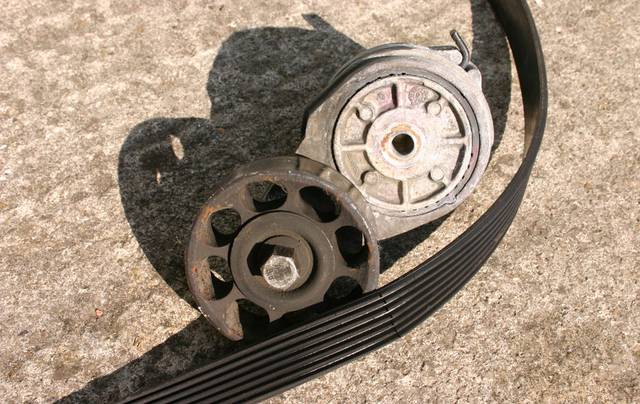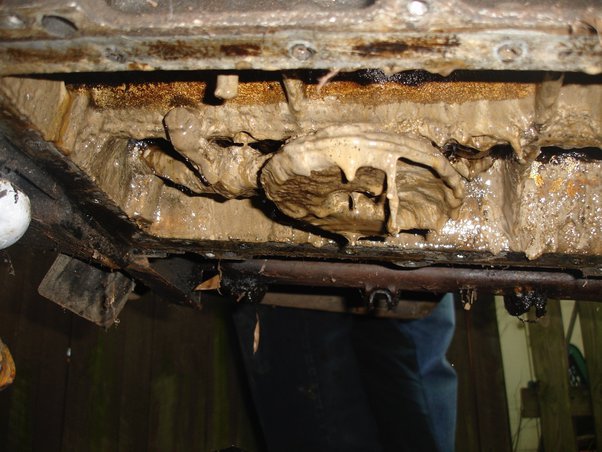Belt Tensioner Replacement Cost
The cost to replace a belt tensioner typically ranges from $140 to $400. Labor costs vary depending on the vehicle make and model.
A belt tensioner ensures the belt drives operate smoothly by maintaining the right amount of tension on your car’s serpentine belt, which powers various accessories like the alternator and AC compressor. Over time, tensioners can wear out or seize, potentially leading to belt slippage or breakage.
Replacing a faulty tensioner promptly is crucial to prevent further vehicle problems. Crafted for motorists, this essential guide provides insights into the investment required for belt tensioner replacement. Remember that neglecting this component might lead to costlier repairs, so regular checkups can save money in the long run. Always consult a trusted mechanic to ensure your car receives the correct maintenance, keeping it running efficiently.

Credit: www.autoguru.com.au
Factors Influencing Belt Tensioner Replacement Cost
Keeping your vehicle in tip-top shape means paying attention to all its components. Let’s look at factors that influence the cost of replacing a belt tensioner. This piece helps keep the engine’s belts tight. A bad tensioner can lead to engine trouble. The cost of replacement varies. We will find out why.
Types Of Belt Tensioners
Different types of tensioners exist. Each type impacts the replacement cost:
- Manual tensioners: These need manual adjustments. They are often cheaper.
- Automatic tensioners: These adjust on their own. They are easier to work with but may cost more.
- Hydraulic tensioners: Used in some cars, they are typically more expensive.
Vehicle Make And Model Impact On Price
The vehicle’s make and model greatly influence the cost. Luxury cars can have higher replacement costs. The two tables below show a cost comparison.
| Vehicle Type | Low Estimated Cost | High Estimated Cost |
|---|---|---|
| Standard | $150 | $300 |
| Luxury | $400 | $600 |
A Honda might have a lower cost than a BMW, for example.
Age and availability: Older models might need harder-to-find parts, driving up the cost.
Regional costs: Labor cost variances also play a role, depending on where you live.
Average Prices For Belt Tensioner Replacement
When the serpentine belt in your vehicle starts to squeal, it’s a clear sign that you may need a belt tensioner replacement. This plays a vital role in keeping your car’s engine running smoothly. The cost can vary, but knowing the average price ensures you’re not overpaying.
Cost Breakdown
Belt tensioner replacement costs include several factors. Parts, labor, and vehicle make influence the total.
- Parts: The belt tensioner itself and a new serpentine belt.
- Labor: Time spent diagnosing and replacing the tensioner.
- Make and Model: Some cars require more expensive parts and labor.
On average, expect to spend between $150 to $350 for a professional replacement.
| Part | Cost |
|---|---|
| Belt Tensioner | $50 – $100 |
| Serpentine Belt | $25 – $75 |
| Labor | $75 – $200 |
Comparing Dealership Vs. Independent Mechanic Costs
Dealerships are generally more expensive due to specialized expertise and OEM parts use. Independent mechanics often charge less and may offer after-market part options and personalized service.
Here’s how the two compare for a belt tensioner replacement:
- Dealership: You might pay $250 to $400
- Independent Mechanic: Costs could be $200 to $350
Symptoms Of A Failing Belt Tensioner
A vehicle’s belt tensioner plays a critical role in keeping the engine’s serpentine belt tight. This belt powers essential components like the alternator and water pump. When a tensioner starts to fail, several signs can alert you to the problem. Recognizing these symptoms early can save time and money by preventing further damage to your engine components.
Unusual Noises From The Engine Bay
One of the most noticeable signs of a failing belt tensioner is strange sounds coming from under the hood. Here’s what to listen for:
- Squeaking: A high-pitched sound when the car starts.
- Chirping: Consistent, short, sharp sounds.
- Grinding: A deeper noise indicating severe wear.
Visible Wear Or Damage
Another clear indicator is visible damage or wear to the tensioner itself. Check for these signs:
- Rust or corrosion: May suggest tensioner weakness.
- Cracks: Obvious breaks or fractures spell trouble.
- Wobble: A tensioner not sitting flush could fail soon.
It’s crucial to inspect both the tensioner and the serpentine belt regularly. Look for wear patterns such as glazing on the belt or tensioner pulley misalignment. These issues, if
left unchecked, could lead to belt failure and costly repairs.
Credit: repairpal.com
The Replacement Process
Is your car’s belt tensioner failing? Fixing it is crucial for a smooth drive. The process involves two main steps: removal and installation. It’s a job for a professional or a seasoned DIY enthusiast. Let’s walk through each phase.
Steps For Belt Tensioner Removal
To start the removal, follow these steps:
- Turn off the engine and ensure safety.
- Locate the tensioner and inspect for wear.
- Loosen the tension with a wrench and slip off the belt.
- Unbolt the tensioner and carefully remove it.
Installation Of The New Tensioner
Installation involves:
- Placing the new tensioner in position.
- Bolting it to the engine firmly.
- Rotating the tensioner to add the belt.
- Checking tension and verifying alignment.
Test your work by running the engine and observing the belt performance. Ensure all tools are removed and parts secured. This guarantees a safe and successful replacement.
Potential Additional Repairs And Costs
Replacing a belt tensioner can often unveil other potential repairs. It’s important to be aware of additional costs that might arise during this process. Components that rely on the same belt may also need attention. Moreover, a close inspection could save you from future breakdowns and costly repairs.
Other Belt-driven Components To Inspect
When a technician replaces the tensioner, they should check other parts that the belt operates with.
- Alternator: The part that charges your battery.
- Water Pump: It circulates coolant in your car’s engine.
- Power Steering Pump: This helps you turn the steering wheel easily.
- Air Conditioning Compressor: Keeps your car cool.
If these parts show wear and tear, it’s wise to address them immediately. This prevents future car troubles.
When To Consider A Full Serpentine Belt System Overhaul
At times, it’s best to consider overhauling the entire belt system. This is especially true when your belt displays significant wear or if multiple components are failing.
| Mileage | Signs of wear | Action |
|---|---|---|
| 50,000-100,000 miles | Cracks or frays | Inspect all components |
| Exceeding lifespan | Glazing or slipping | Consider replacement |
| During tensioner replacement | Noisy or loose bearings | Overhaul may be necessary |
Replacing the entire belt system can be more cost-effective in the long run. It ensures that all components work together smoothly.

Credit: www.autoguru.com.au
Saving Money On Belt Tensioner Replacement
A belt tensioner ensures your vehicle’s belts run smoothly. Over time, it may wear out or fail. Replacing it doesn’t have to break the bank. Read on for smart ways to save on belt tensioner replacement.
Shop Around For Parts And Labor
Belt tensioner prices can vary widely. Start by comparing costs from different suppliers. Local auto shops, online retailers, and wholesalers may offer different prices. Check for quality and warranty options before making a purchase.
Labor costs can also fluctuate. Seek quotes from various mechanics. Don’t overlook local independent garages, as they often provide the same service for less. Here are some tips for finding the best deal:
- Request estimates from multiple mechanics.
- Consider independent garages over dealerships.
- Look for special deals and discounts.
Diy Replacement Considerations
Doing the replacement yourself can save labor costs. But, assess your skills honestly.
A belt tensioner replacement requires:
- Basic mechanical knowledge.
- The right tools for the job.
- Understanding of your vehicle’s engine layout.
Consider the following before you decide on DIY:
| Consideration | Why It’s Important |
|---|---|
| Access to a manual | Gives step-by-step guidance for your car model. |
| Tool availability | Ensures you can complete the job without issues. |
| Time commitment | Ensures you have enough time to do the job right. |
If you’re not confident, it’s best to leave it to the professionals. Remember, a correctly done job ensures longer belt life and prevents future costs.
Frequently Asked Questions For Belt Tensioner Replacement Cost
What Affects Belt Tensioner Replacement Costs?
The cost of replacing a belt tensioner is influenced by vehicle model, part quality, and labor rates. OEM parts generally cost more than aftermarket ones. Additionally, the complexity of installation and regional labor costs will impact the final price.
Can I Drive With A Faulty Belt Tensioner?
Driving with a faulty belt tensioner is risky. It can lead to belt slippage or snapping, causing engine overheating, power steering, and charging system failure. It’s recommended to replace it promptly to avoid further vehicle damage.
How Long Does Belt Tensioner Replacement Take?
Replacing a belt tensioner generally takes between 1 to 2 hours. The time can vary based on the accessibility of the tensioner and the mechanic’s experience. Some vehicles may require more labor time than others.
Are Belt Tensioners Covered Under Warranty?
Belt tensioners may be covered under a car’s powertrain warranty. However, coverage depends on the warranty terms and vehicle age. Regular wear items are usually excluded after the initial warranty period.
Conclusion
Replacing your vehicle’s belt tensioner is crucial for ensuring a smooth ride and preventing costly breakdowns. On average, the cost varies depending on the make and model, but investing in this maintenance can save you from future expenses. For reliable operation, factor in this replacement to your car care budget; it’s a small price for peace of mind on the road.



